Planning Recreation around Water Bodies in Two Hard Coal Post-Mining Areas in Southern Poland
Abstract
1. Introduction
2. Research Overview
3. Methods, Materials and Study Area
3.1. Methods and Materials
- (1)
- (Q): How often do you visit water bodies in and around the city?(A): Every day/a few times a week/a few times a month/a few times a year/not at all.
- (2)
- (Q): Should poorly developed water bodies be left to experience using their natural values or rather be developed to strengthen their recreational functions?(A): Leave to nature/enhance recreational functions/try to balance/do not know.
- (3)
- (Q): What problems do you see concerning water bodies and their surroundings?(A): Poor accessibility by public transport/poor accessibility by car, including lack of car parks/no possibility of swimming/no possibility for recreational use of the water in other ways/poor infrastructure around the reservoir/too-intensive development/devastation or littering/overabundance of visitors/no information about the reservoir and attractions/nature threats—wild animals, ticks (infected with Lyme disease), vipers/none of the above (other).
3.2. Study Area
4. Results
4.1. Results of Research on the Development of Post-Mining Reservoirs in the Katowice Conurbation
4.2. Results of Opinion Polls of Representatives of Social Stakeholders
4.3. Social Needs Concerning Urban Water Bodies in Post-Mining Areas in the Katowice Conurbation
4.4. Findings
5. Discussion
6. Conclusions
Author Contributions
Funding
Institutional Review Board Statement
Informed Consent Statement
Data Availability Statement
Conflicts of Interest
References
- Pacione, M. Urban Geography: A Global Perspective, 3rd ed.; Routledge: New York, NY, USA, 2009. [Google Scholar]
- Schneider-Sliwa, R. Exogenous and Endogenous Concepts of Urban Planning: Urban Revitalization in Kingston, Jamaica. Erde 1991, 122, 3–22. Available online: https://edoc.unibas.ch/dok/A6289158 (accessed on 26 June 2023).
- Verma, L.N. Urban Geography; Publisher Rawat Publications: Jaipur, India, 2006. [Google Scholar]
- Marot, N.; Harfst, J. Post-mining landscapes and their endogenous development potential for small- and medium-sized towns: Examples from Central Europe. Extr. Ind. Soc. 2021, 8, 168–175. [Google Scholar] [CrossRef]
- Wirth, P.; Chang, J.; Syrbe, R.-U.; Wende, W.; Hu, T. Green infrastructure: A planning concept for the urban transformation of former coal-mining cities. Int. J. Coal. Sci. Technol. 2018, 5, 78–91. [Google Scholar] [CrossRef]
- Derek, M. Urban recycling. Spaces for leisure in Polish urban brownfield sites. Geogr. Polonica 2016, 89, 555–561. Available online: https://rcin.org.pl/Content/61199/WA51_80336_r2016-t89-no4_G-Polonica-Derek.pdf (accessed on 26 June 2023).
- Duží, B.; Jakubínský, J. Brownfield dilemmas in the transformation of post-communist cities: A case study of Ostrava, Czech Republic. Hum. Geogr.–J. Stud. Res. Hum. Geogr. 2013, 7, 53–64. [Google Scholar] [CrossRef]
- Hula, R.C.; Reese, L.A.; Jackson-Elmoore, C. Reclaiming Brownfields. A Comparative Analysis of Adaptive Reuse of Contaminated Properties; Routledge: New York, NY, USA, 2016. [Google Scholar]
- Oei, P.-Y.; Brauers, H.; Herpich, P. Lessons from Germany’s hard coal mining phase-out: Policies and transition from 1950 to 2018. Clim. Policy 2020, 20, 963–979. [Google Scholar] [CrossRef]
- Rzętała, M. Funkcjonowanie Zbiorników Wodnych Oraz Przebieg Procesów Limnicznych w Warunkach Zróżnicowanej Antropopresji na Przykładzie Regionu Górnośląskiego [Functioning of Water Bodies and the Course of Limnic Processes under Conditions of Varied Anthropopression a Case Study of Upper Silesian Region]; Wydawnictwo Uniwersytetu Śląskiego [University of Silesia Publishing House]: Katowice, Poland, 2008. [Google Scholar]
- Fleming, G. (Ed.) Recycling Derelict Land; Thomas Telford: London, UK, 1991. [Google Scholar]
- Gonzalez, J.J., III; McGalliard, T.; Dayrit, I. (Eds.) Brownfields Redevelopment: Case Studies and Concepts in Community Revitalization; McFarland & Company: Jefferson, NC, USA, 2021. [Google Scholar]
- Krzysztofik, R.; Kantor-Pietraga, I.; Spórna, T. A Dynamic Approach to the Typology of Functional Derelict Areas (Sosnowiec, Poland). Morav. Geogr. Rep. 2013, 21, 20–35. [Google Scholar] [CrossRef]
- Mahammedi, C.; Mahdjoubi, L.; Booth, C.; Bowman, R.; Butt, T.E. Criteria for Preliminary Risk Assessment of Brownfield Site: An International Survey of Experts. Environ. Manag. 2022, 70, 681–696. [Google Scholar] [CrossRef] [PubMed]
- Hawkins, A.B.; Tomlinson, D. Investigation procedure evolved during a large development on the Bristol Coalfield. In Building on Marginal and Derelict Land: Proceedings of a Conference Organized by the Institution of Civil Engineers and Held in Glasgow on 7–9 May 1986; Telford: London, UK, 1987; pp. 197–212. [Google Scholar]
- Dragan, W.; Zdyrko, A. The spatial dimension of coal phase-out: Exploring economic transformation and city pathways in Poland. Energy Res. Soc. Sci. 2023, 99, 103058. [Google Scholar] [CrossRef]
- Brears, R.C. Blue and Green Cities. In The Role of Blue-Green Infrastructure in Managing Urban Water Resources; Palgrave Macmillan: London, UK, 2018. [Google Scholar]
- Sasidharan, V.; And, F.W.; Godbey, G. Cultural differences in urban recreation patterns: An examination of park usage and activity participation across six population sub-groups. Manag. Leisur. 2005, 10, 19–38. [Google Scholar] [CrossRef]
- Schneider, I.E. Urban Water Recreation: Experiences, Place Meanings, and Future Issues. In The Water Environment of Cities; Baker, L.A., Ed.; Springer: Boston, MA, USA, 2009; pp. 125–140. [Google Scholar]
- Day, B.H. The Value of Greenspace Under Pandemic Lockdown. Environ. Resour. Econ. 2020, 76, 1161–1185. [Google Scholar] [CrossRef]
- Venter, Z.S.; Barton, D.N.; Gundersen, V.; Figari, H.; Nowell, M. Urban nature in a time of crisis: Recreational use of green space increases during the COVID-19 outbreak in Oslo, Norway. Environ. Res. Lett. 2020, 15, 104075. [Google Scholar] [CrossRef]
- Beute, F.; Davies, Z.; de Vries, S.; Glanville, J.; Keune, H.; Lammel, A.; Marselle, M.; O’Brien, L.; Olszewska-Guizzo, A.; Remmen, R.; et al. Blue space in urban and peri-urban areas and mental health: Which blue space types and characteristics are most beneficial? In Green and Blue Spaces and Mental Health: New Evidence and Perspectives for Action; WHO Regional Office for Europe: Copenhagen, Denmark, 2021; pp. 24–27. Available online: https://eprints.glos.ac.uk/id/eprint/10028 (accessed on 26 June 2023).
- Brückner, A.; Falkenberg, T.; Heinzel, C.; Kistemann, T. The Regeneration of Urban Blue Spaces: A Public Health Intervention? Reviewing the Evidence. Front. Public Health 2022, 9, 782101. [Google Scholar] [CrossRef]
- Smith, N.; Georgiou, M.; King, A.C.; Tieges, Z.; Webb, S.; Chastin, S. Urban blue spaces and human health: A systematic review and meta-analysis of quantitative studies. Cities 2021, 119, 103413. [Google Scholar] [CrossRef]
- Lindsey, G.; Man, J.; Payton, S.; Dickson, K. Property values, recreation values and urban greenways. J. Park Recreat. Adm. 2004, 22, 69–90. [Google Scholar]
- Franz, M.; Güles, O.; Prey, G. Place-Making and ‘Green’ Reuses of Brownfields in the Ruhr. Tijdschr. Voor Econ. En Soc. Geogr. 2008, 99, 316–328. [Google Scholar] [CrossRef]
- Harfst, J.; Wirth, P. Structural Change in former mining regions: Problems, potentials and capacities in multi-level governance systems. Procedia Soc. Behav. Sci. 2011, 14, 167–176. [Google Scholar] [CrossRef]
- Rizzo, E.; Pesce, M.; Pizzol, L.; Alexandrescu, F.M.; Giubilato, E.; Critto, A.; Marcomini, A.; Bartke, S. Brownfield regeneration in Europe: Identifying stakeholder perceptions, concerns, attitudes and information needs. Land Use Policy 2015, 48, 437–453. [Google Scholar] [CrossRef]
- Wirth, P.; Cernic-Mali, B.; Fischer, W. (Eds.) Post-Mining Regions in Central Europe–Problems, Potentials, Possibilities; Oekom: Munich, Germany, 2012. [Google Scholar]
- Wong, M.H.; Bradshaw, A.D. (Eds.) The Restoration and Management of Derelict Land. Modern Approaches; World Scientific Publishing Company: Singapore, 2003. [Google Scholar]
- Khomitch, S.; Ramanchuk, A.; Daniltchenko, A.; Rzętała, M. Key factors for tourist and recreational use of quarry ponds of Belarus and Poland. Geoj. Tour. Geosites 2019, 27, 1114–1133. [Google Scholar] [CrossRef]
- Albert, C.; Von Haaren, C. Implications of applying the green infrastructure concept in landscape planning for ecosystem services in peri-urban areas: An expert survey and case study. Plan. Pract. Res. 2017, 32, 227–242. [Google Scholar] [CrossRef]
- Rosa, J.C.S.; Sánchez, L.E.; Morrison-Saunders, A. Getting to ‘agreed’ post-mining land use–An ecosystem services approach. Impact Assess. Proj. Apprais. 2018, 36, 220–229. [Google Scholar] [CrossRef]
- Valente de Macedo, L.S.; Barda Picavet, M.E.; Puppim de Oliveira, J.A.; Shih, W.Y. Urban green and blue infrastructure: A critical analysis of research on developing countries. J. Clean. Prod. 2021, 313, 127898. [Google Scholar] [CrossRef]
- Vallecillo, S.; Polce, C.; Barbosa, A.; Perpiña Castillo, C.; Vandecasteele, I.; Rusch, G.M.; Maes, J. Spatial alternatives for Green Infrastructure planning across the EU: An ecosystem service perspective. Landsc. Urban Plan. 2018, 174, 41–54. [Google Scholar] [CrossRef]
- Kretschmann, J. Post-Mining—A Holistic Approach. Min. Metall. Explor. 2020, 37, 1401–1409. [Google Scholar] [CrossRef]
- Forman, R.T.T. Urban Ecology. Science of Cities; University Press: Cambridge, UK, 2016. [Google Scholar]
- O’Sullivan, P.E. On The Value of Lakes. In The Lakes Handbook, Volume 2: Lake Restoration and Rehabilitation; O’Sullivan, P.E., Reynolds, C.S., Eds.; John Wiley & Sons, Inc: Hoboken, NJ, USA, 2008; pp. 3–24. [Google Scholar]
- Żółtaszek, A.; Stodulska, M. Blue and Green Infrastructure and the Real Estate Market. Acta Univ. Lodz. Folia Oecon. 2022, 6, 24–38. [Google Scholar] [CrossRef]
- Kaufman, M.M.; Rogers, D.T.; Murray, K.S. Urban Watersheds: Geology, Contamination and Sustainable Development; CRC Press: Boca Raton, FL, USA, 2011. [Google Scholar]
- Klusáček, P.; Alexandrescu, F.; Osman, R.; Malý, J.; Kunc, J.; Dvořák, P.; Frantal, B.; Havlíček, M.; Krejčí, T.; Martinát, S.; et al. Good governance as a strategic choice in brownfield regeneration: Regional dynamics from the Czech Republic. Land Use Policy 2018, 73, 29–39. [Google Scholar] [CrossRef]
- Siikamäki, J.; Wernstedt, K. Turning brownfields into greenspaces: Examining incentives and barriers to revitalization. J. Health Polit. Policy Law 2008, 33, 559–593. [Google Scholar] [CrossRef]
- Syrbe, R.U. Recultivation and sustainable development of post-mining landscapes. In Legislation, Technology and Practice of Mine Land Reclamation; Hu, Z.Q., Ed.; CRC Press: London, UK, 2015; pp. 489–492. [Google Scholar]
- Dulias, R. Landscape planning in areas of sand extraction in the Silesian Upland, Poland. Landsc. Urban Plan. 2010, 95, 91–104. [Google Scholar] [CrossRef]
- Krzysztofik, R.; Dulias, R.; Kantor-Pietraga, I.; Spórna, T.; Dragan, W. Paths of urban planning in a post-mining area. A case study of a former sandpit in southern Poland. Land Use Policy 2020, 99, 104801. [Google Scholar] [CrossRef]
- Clinch, J.P. (Ed.) Greening the Budget: Budgetary Policies for Environmental Improvement; Edward Elgar Publishing: Cheltenham Glos, UK, 2002. [Google Scholar]
- Rydvalova, P.; Zizka, M. Redevelopment Strategy of Brownfield Sites in the Czech Republic. In Reclaiming Brownfields. A Comparative Analysis of Adaptive Reuse of Contaminated Properties; Reese, L.A., Hula, R.C., Eds.; Routledge: London, UK; New York, NY, USA, 2012; pp. 89–120. [Google Scholar]
- Bowler, D.E.; Buyung-Ali, L.; Knight, T.M.; Pullin, A.S. Urban greening to cool towns and cities: A systematic review of the empirical evidence. Landsc. Urban Plan. 2010, 97, 147–155. [Google Scholar] [CrossRef]
- Twohig-Bennett, C.; Jones, A. The health benefits of the great outdoors: A systematic review and meta-analysis of greenspace exposure and health outcomes. Environ. Res. 2018, 166, 628–637. [Google Scholar] [CrossRef] [PubMed]
- Bertram, C.; Meyerhoff, J.; Rehdanz, K.; Wüstemann, H. Differences in the recreational value of urban parks between weekdays and weekends: A discrete choice analysis. Landsc. Urban Plan. 2017, 159, 5–14. [Google Scholar] [CrossRef]
- Blanchette, M.L.; Lund, M.A. Pit lakes are a global legacy of mining: An integrated approach to achieving sustainable ecosystems and value for communities. Curr. Opin. Environ. Sustain. 2016, 23, 28–34. [Google Scholar] [CrossRef]
- Langer, P. Contemporary identity of mining towns–example of bavarian mines in Oberpfalz region. Czas. Tech. 2015, 2-A, 119–134. [Google Scholar] [CrossRef]
- McCullough, C.D.; Lund, M.A. Opportunities for Sustainable Mining Pit Lakes in Australia. Mine Water Environ. 2006, 25, 220–226. [Google Scholar] [CrossRef]
- Nelson, E.; Rogers, M.; Wood, S.A.; Chung, J.; Keeler, B. Data-driven predictions of summertime visits to lakes across 17 US states. Ecosphere 2023, 14, e4457. [Google Scholar] [CrossRef]
- Wheeler, D.; Shaw, G.; Barr, S. Statistical Techniques in Geographical Analysis; A David Fulton Book; Routledge: London, UK; New York, NY, USA, 2005. [Google Scholar]
- Studium Uwarunkowań i Kierunków Zagospodarowania Przestrzennego Miasta Katowice [Katowice—Master Plan—Study of the Conditions and Directions for Spatial Development]; Municipal Office in Katowice: Katowice, Poland, 2012.
- Strategia Rozwoju Miasta “Katowice 2030” [Strategy for the Development of City “Katowice 2030”]; Municipal Office in Katowice: Katowice, Poland, 2015.
- Strategia Rozwoju Miasta Sosnowca do 2020, r. [Strategy for the Development of City Sosnowiec until 2020]; Municipal Office in Sosnowiec: Sosnowiec, Poland, 2007.
- Studium Uwarunkowań i Kierunków Zagospodarowania Przestrzennego Miasta Sosnowca [Sosnowiec—Master Plan—Study of the Conditions and Directions for Spatial Development]; Municipal Office in Sosnowiec: Sosnowiec, Poland, 2016.
- Program Działań Strategicznych Górnośląsko-Zagłębiowskiej Metropolii Do Roku 2022 [Program of Strategic Activities of the Upper Silesian and Zagłębie Metropolis until 2022], Załącznik Do Uchwały XII/73/2018 Zgromadzenia Górnośląsko-Zagłębiowskiej Metropolii z Dnia 30 Listopada 2018 r., Katowice. Available online: https://bip.metropoliagzm.pl/artykul/34552/125421/program-dzialan-strategicznych-gornoslasko-zaglebiowskiej-metropolii-do-roku-2022 (accessed on 29 July 2022).
- Strategia Rozwoju Województwa Śląskiego “Śląskie 2020+” [Silesian Voivodeship Development Strategy “Śląskie 2020+”]; Wydział Planowania Strategicznego i Przestrzennego Urząd Marszałkowski Województwa Śląskiego: Katowice, Poland, 2013.
- Dziennik Zachodni-Wiadomości Śląsk, Wiadomości Śląskie. Available online: https://dziennikzachodni.pl/ (accessed on 3 December 2022).
- Urząd Miasta Katowice [Municipal Office in Katowice]. Available online: www.katowice.eu (accessed on 20 October 2022).
- Sosnowiec Łączy–Oficjalny Serwis Internetowy Sosnowca [Sosnowiec Connects–The Official Website of Sosnowiec]. Available online: www.sosnowiec.pl (accessed on 29 October 2022).
- Dulias, R. Denudacja Antropogeniczna na Obszarach Górniczych na Przykładzie Górnośląskiego Zagłębia Węglowego [Anthropogenic Denudation in Mining Areas on the Example of the Upper Silesian Coal Basin]; Wydawnictwo Uniwersytetu Śląskiego [University of Silesia Publishing House]: Katowice, Poland, 2013. [Google Scholar]
- Rzętała, M.; Jaguś, A. New lake district in Europe: Origin and hydrochemical characteristics. Water Environ. J. 2012, 26, 108–117. [Google Scholar] [CrossRef]
- Molenda, T. Impact of Saline Mine Water: Development of a Meromictic Reservoir in Poland. Mine Water Environ. 2014, 33, 327–334. [Google Scholar] [CrossRef]
- Rzętała, M.A.; Solarski, M.; Rzętała, M.; Pradela, A. Eutrophication of water reservoirs under anthropogenic, agricultural and industrial impacts (example of Southern Poland). Res. J. Chem. Environ. 2014, 18, 49–55. [Google Scholar]
- Solarski, M.; Pradela, A.; Rzetala, M. Oxygen conditions in anthropogenic lakes of the Silesian Upland (Southern Poland). In Proceedings of the 12th International Multidisciplinary ScientificGeoconference (SGEM), Albena, Bulgaria, 17–23 June 2012; Volume III, pp. 785–792. [Google Scholar]
- Rzetala, M.A.; Machowski, R.; Solarski, M.; Bakota, D.; Płomiński, A.; Rzetala, M. Toxic Metals, Non-Metals and Metalloids in Bottom Sediments as a Geoecological Indicator of a Water Body’s Suitability for Recreational Use. Int. J. Environ. Res. Public Health 2023, 20, 4334. [Google Scholar] [CrossRef]
- Machowski, R.; Rzetala, M.A.; Rzetala, M.; Solarski, M. Anthropogenic enrichment of the chemical composition of bottom sediments of water bodies in the neighborhood of a non-ferrous metal smelter (Silesian Upland, Southern Poland). Sci. Rep. 2019, 9, 14445. [Google Scholar] [CrossRef]
- Rzętała, M.A. Wybrane Przemiany Geomorfologiczne Mis Zbiorników Wodnych i Ocena Zanieczyszczeń Osadów Zbiornikowych w Warunkach Zróżnicowanej Antropopresji (Na Przykładzie Regionu Górnośląsko-Zagłębiowskiego) [Selected Geomorphological Transformations of Water Basins and Assessment of Reservoir Sediment Pollution under Conditions of Various Anthropopressure (on the Example of the Upper Silesian-Zagłębie Region)]; Uniwersytet Śląski: Katowice, Poland, 2014. [Google Scholar]
- Popelková, R.; Mulková, M. The mining landscape of the Ostrava-Karviná coalfield: Processes of landscape change from the 1830s to the beginning of the 21st century. Appl. Geogr. 2018, 90, 28–43. [Google Scholar] [CrossRef]
- Krawczyk, J.A.; Nadolski, P. Atlas Geograficzny Bytomia [Geographical Atlas of City of Bytom]; Rococo—J. Krawczyk: Bytom, Poland, 2007. [Google Scholar]
- Solarski, M.; Krzysztofik, R. Is the Naturalization of the Townscape a Condition of De-Industrialization? An Example of Bytom in Southern Poland. Land 2021, 10, 838. [Google Scholar] [CrossRef]
- Czaja, S. Zmiany Stosunków Wodnych w Warunkach Silnej Antropopresji (Na Przykładzie Konurbacji Katowickiej) [Changes in Water Relations under the Conditions of Strong Anthropopression (a Case Study of Katowice Conurbation)]; Wydawnictwo Uniwersytetu Śląskiego [University of Silesia Publishing House]: Katowice, Poland, 1999. [Google Scholar]
- Borowik, A. Park Śląski w Chorzowie. Projekty i Realizacje z Lat 1950–1989 [Silesian Park in Chorzów. Projects and Realizations from 1950–1989]; Neriton: Warsaw, Poland, 2020. [Google Scholar]
- Jankowski, A.T.; Molenda, T.; Rzętała, M. Reservoirs in subsidence basins and depression hollows in the Silesian Upland–selected hydrological matters. Limnol. Rev. 2001, 1, 143–150. [Google Scholar]
- Machowski, R.; Rzetala, M.A.; Rzetala, M.; Solarski, M. Geomorphological and Hydrological Effects of Subsidence and Land use Change in Industrial and Urban Areas. Land Degrad. Dev. 2016, 27, 1740–1752. [Google Scholar] [CrossRef]
- De Sousa, C.A.; Wu, C.; Westphal, L.M. Assessing the Effect of Publicly Assisted Brownfield Redevelopment on Surrounding Property Values. Econ. Dev. Q. 2009, 23, 95–110. [Google Scholar] [CrossRef]
- Kaufman, D.A.; Cloutier, N.R. The Impact of Small Brownfields and Greenspaces on Residential Property Values. J. Real Estate Financ. Econ. 2006, 33, 19–30. [Google Scholar] [CrossRef]
- Turečková, K.; Martinát, S.; Nevima, J.; Varadzin, F. The Impact of Brownfields on Residential Property Values in Post-Industrial Communities: A Study from the Eastern Part of the Czech Republic. Land 2022, 11, 804. [Google Scholar] [CrossRef]
- Krzysztofik, R.; Rahmonov, O.; Kantor-Pietraga, I.; Dragan, W. The Perception of Urban Forests in Post-Mining Areas: A Case Study of Sosnowiec-Poland. Int. J. Environ. Res. Public Health 2022, 19, 3852. [Google Scholar] [CrossRef]
- Krzysztofik, R.; Dragan, W.; Soida, K. A unique type of industrial railway–the sand railways of southern Poland. Environ. Socio-Econ. Stud. 2022, 10, 1–11. [Google Scholar] [CrossRef]
- Lovell, S.T.; Taylor, J.R. Supplying urban ecosystem services through multifunctional green infrastructure in the United States. Landsc. Ecol. 2013, 28, 1447–1463. [Google Scholar] [CrossRef]
- Wagner, I.; Krauze, K.; Zalewski, M. Blue aspects of green infrastructure. Sustain. Dev. Appl. 2013, 4, 145–155. [Google Scholar]
- Solís, A.F.; Zhu, X. Water Markets: Insights from an Applied General Equilibrium Model for Extremadura, Spain. Water Resour. Manag. 2015, 29, 4335–4356. [Google Scholar] [CrossRef]
- Larraz, B.; San-Martin, E.A. Tale of Two Dams: The Impact of Reservoir Management on Rural Depopulation in Central Spain. Water Resour. Manag. 2021, 35, 4769–4787. [Google Scholar] [CrossRef]
- Keeler, B.L.; Wood, S.A.; Polasky, S.; Kling, C.; Filstrup, C.T.; Downing, J.A. Recreational demand for clean water: Evidence from geotagged photographs by visitors to lakes. Front. Ecol. Environ. 2015, 13, 76–81. [Google Scholar] [CrossRef]
- Strategia Rozwoju Górnośląsko-Zagłębiowskiej Metropolii na Lata 2022–2027, z Perspektywą do 2035 r. [Strategy for the Development of the Upper Silesian and Zagłębie Metropolis for the Years 2022–2027, with a Perspective until 2035]; The Upper Silesian-Zagłębie Metropolis: Katowice, Poland, 2022.
- Pediaditi, K.; Doick, K.J.; Moffat, A.J. Monitoring and evaluation practice for brownfield, regeneration to greenspace initiatives: A meta-evaluation of assessment and monitoring tools. Landsc. Urban Plan. 2010, 97, 22–36. [Google Scholar] [CrossRef]
- Mapy. Zanim Wytną Twój Las-Lasy i Obywatele [Maps. Before They Cut Your Forest-Forests and Citizens]. Available online: http://mapy.lasyiobywatele.pl/zanim-wytna-twoj-las (accessed on 5 December 2021).
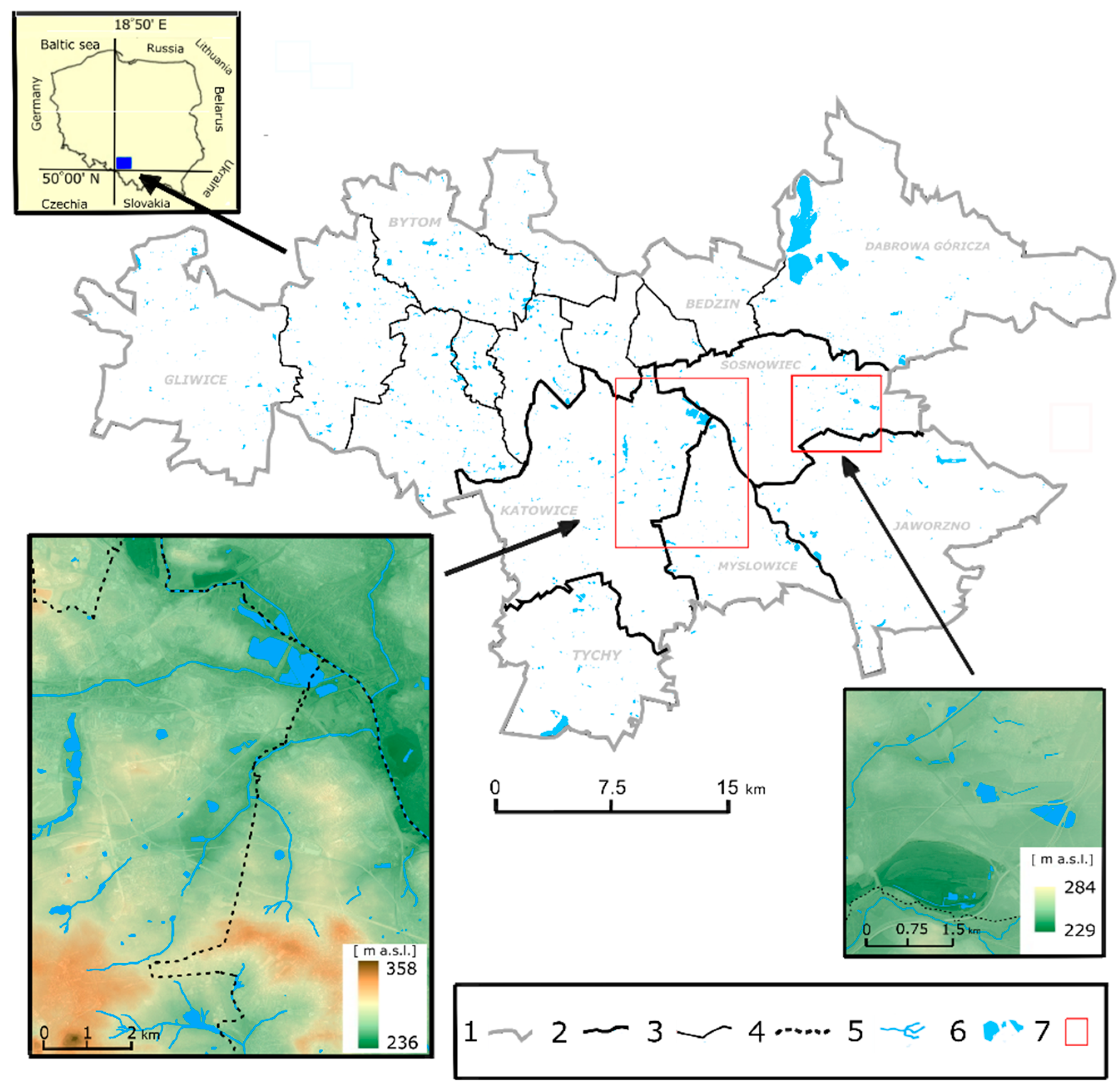
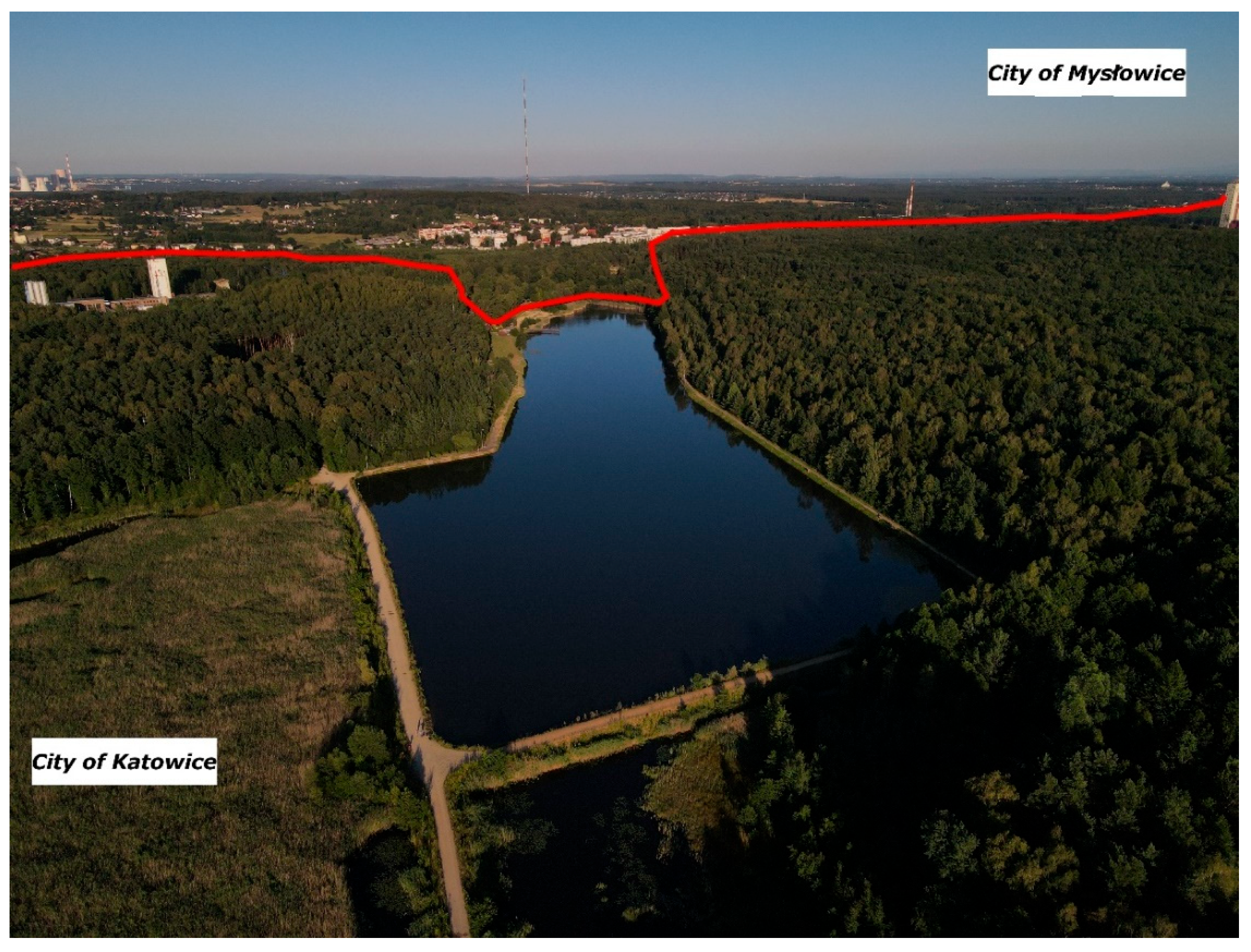
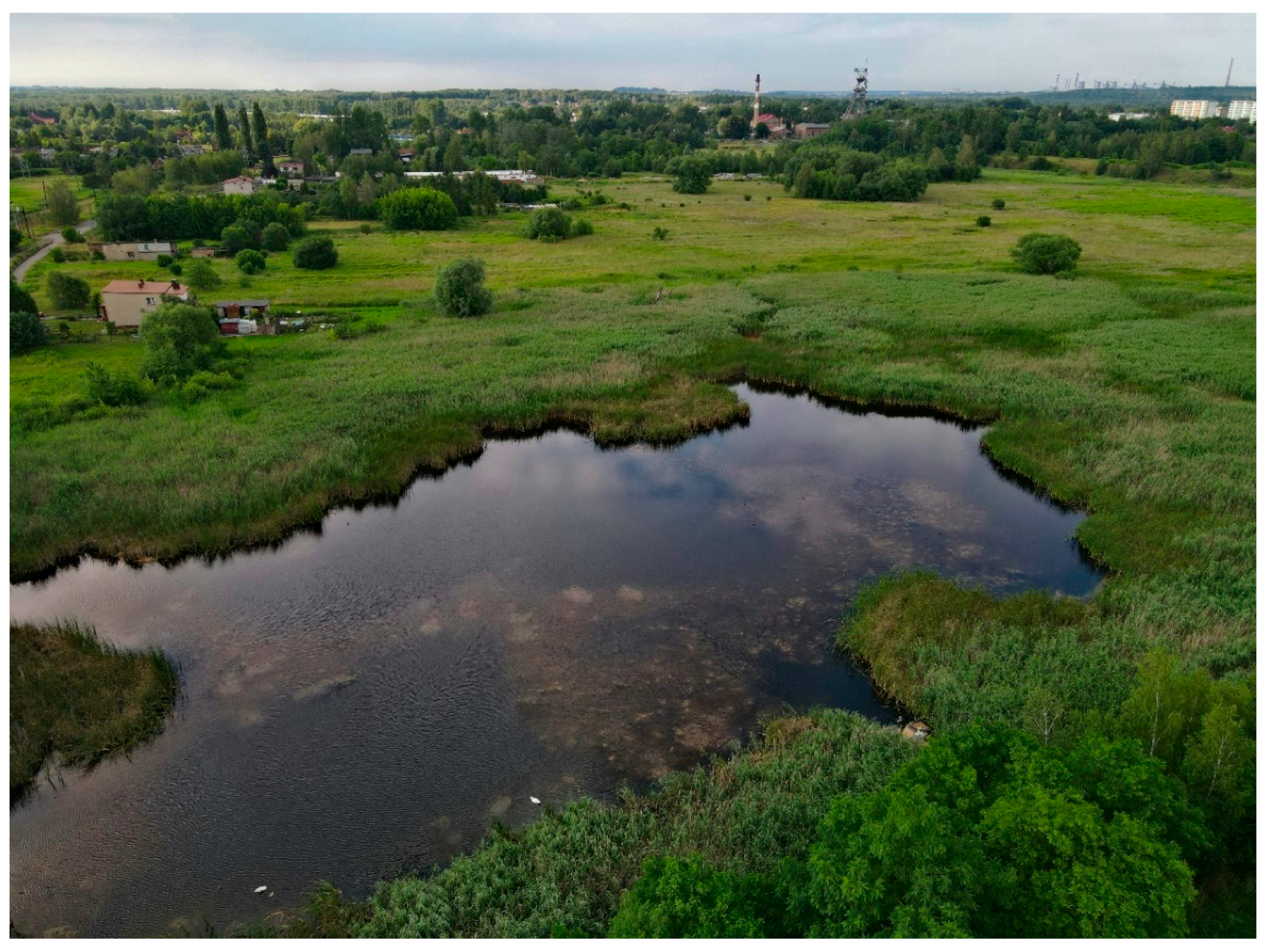
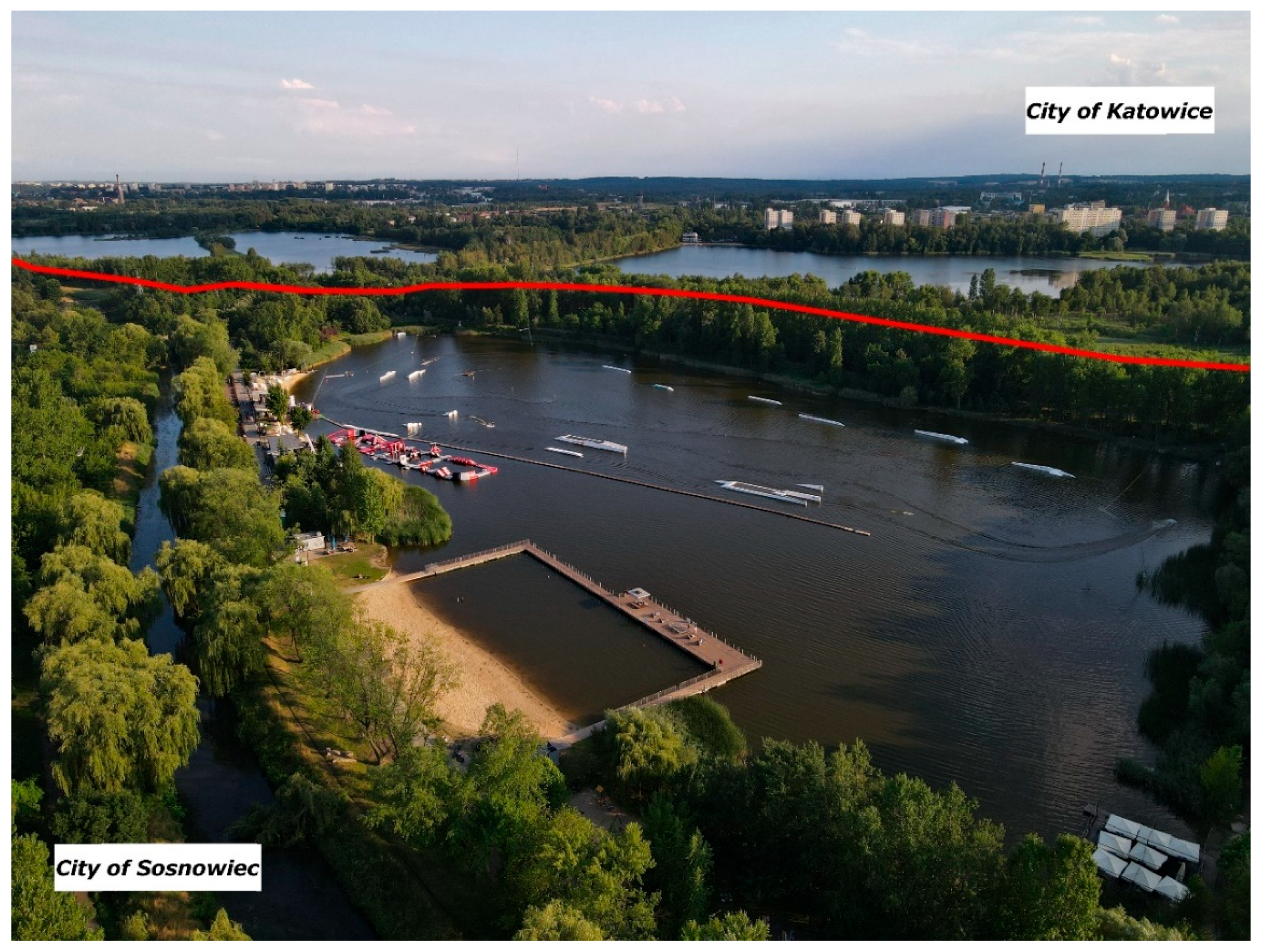
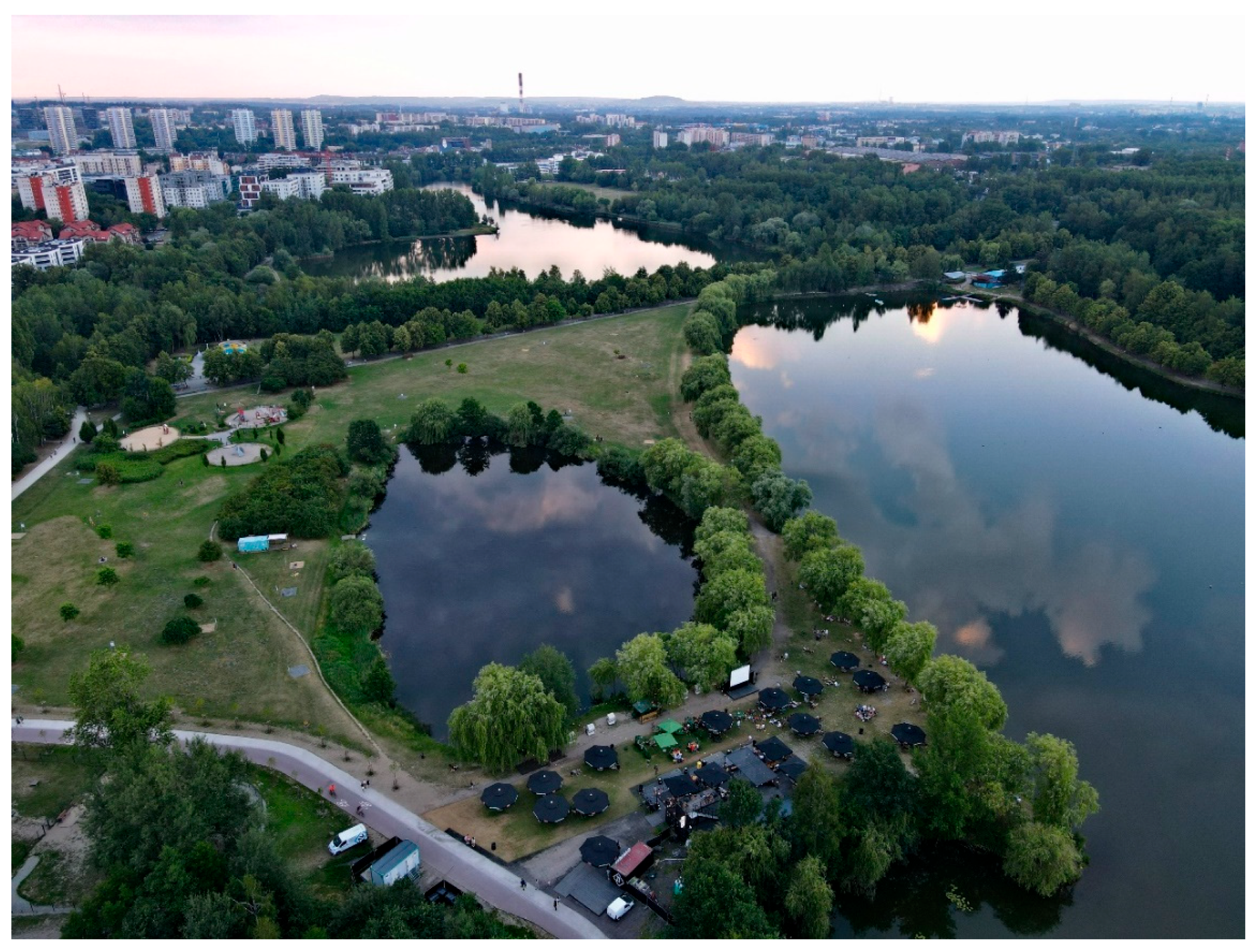
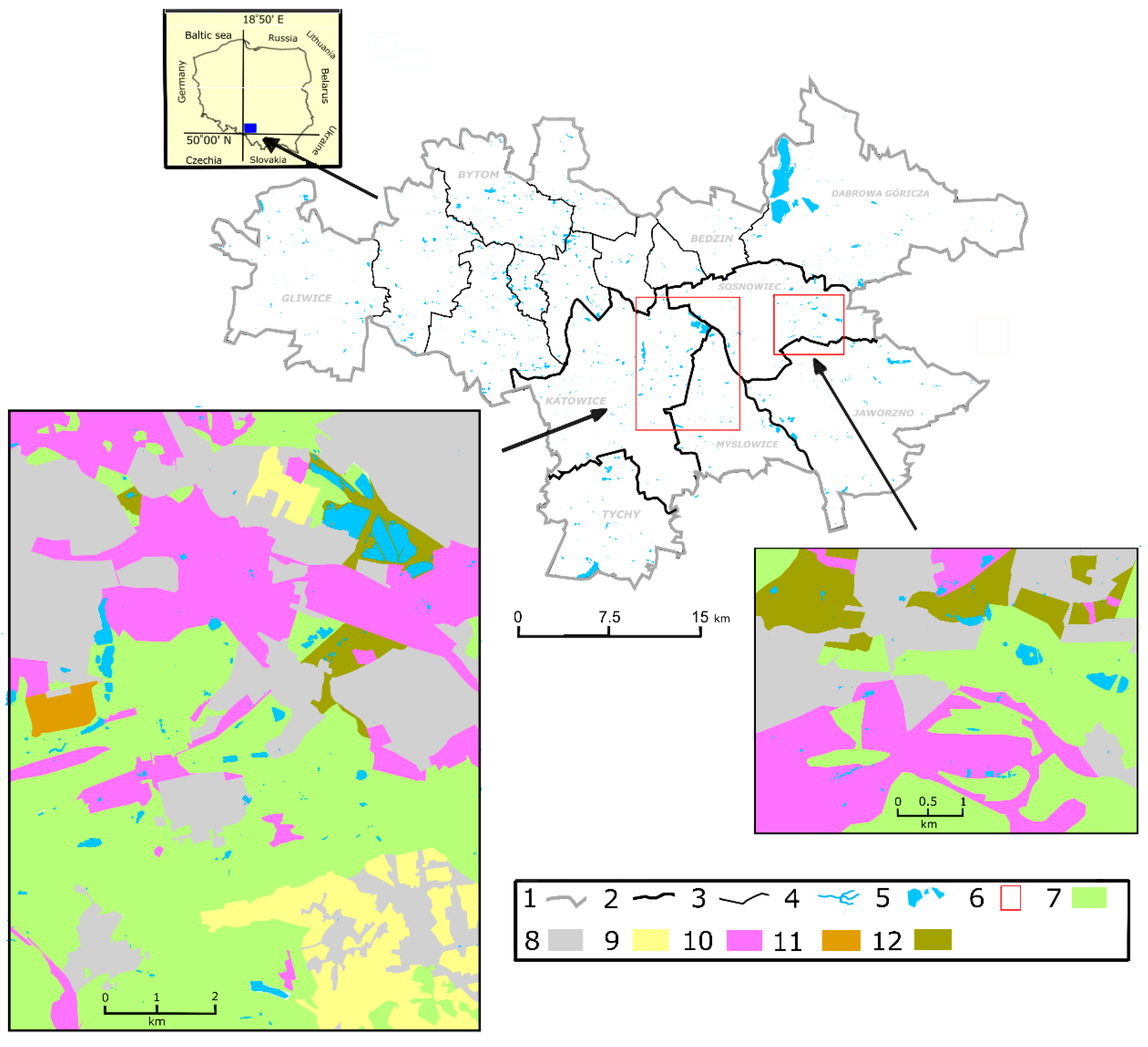
| Water Body Name | Geographical Coordinates | Total Capacity | Maximum Area | Electrolytic Conductivity | Nitrates (NO3−) | Phosphates (PO43−) | |
|---|---|---|---|---|---|---|---|
| Latitude | Longitude | (dam3) | (ha) | (μS/cm) | (mg/dm3) | (mg/dm3) | |
| Stawiki | 50°16′25.56″ N | 19°06′35.59″ E | 131 | 7.6 | 784.5 | 26.0 | 0.09 |
| Morawa | 50°16′24.56″ N | 19°07′19.57″ E | 693 | 34.7 | 380.0 | 37.8 | 3.49 |
| Hubertus I | 50°15′46.37″ N | 19°06′41.59″ E | 142 | 6.7 | 1102.0 | 21.0 | 0.14 |
| Gliniak | 50°15′53.55″ N | 19°07′00.54″ E | 824 | 38.7 | 512.1 | 2.2 | 0.06 |
| Hubertus II | 50°15′37.59″ N | 19°07′23.27″ E | 140 | 6.7 | 165.0 | 6.6 | No data |
| Pekin | 50°17′02.44″ N | 19°14′05.59″ E | 1 | 0.8 | 1326.0 | 0.9 | 0.07 |
| Milicyjny | 50°14′07.58″ N | 19°02′31.56″ E | 43 | 4.7 | 730.0 | 5.1 | 0.09 |
| Mały | 50°14′25.57″ N | 19°02′42.59″ E | 9 | 1.0 | 689.0 | 11.6 | 0.09 |
| Łąka | 50°15′00.58″ N | 19°02′42.00″ E | 290 | 12.7 | 774.5 | 19.1 | 0.12 |
| Ozdobny | 50°14′46.29″ N | 19°02′34.24″ E | 6 | 1.2 | 401.0 | 3.8 | 0.06 |
| Wesoła-Fala | 50°19′33.45″ N | 19°08′47.24″ E | No data | 9.0 | No data | No data | No data |
| The Katowice Conurbation | The Ostrava Region | The Ruhr Conurbation |
|---|---|---|
| Hard coal mines and sand mines | Hard coal mines and gravel mines | Hard coal mines |
| A large number of post-mining reservoirs | An average number of post-mining reservoirs | A small number of post-mining reservoirs |
| Large- and medium-sized reservoirs predominate in the total area | Small- and medium-sized reservoirs predominate in the total area | Small reservoirs predominate in the total area |
| Most reservoirs in moderately urbanized surroundings | Most reservoirs in poorly urbanized surroundings | Most reservoirs in highly urbanized surroundings |
| Area | Number of Water Bodies | Area in km2 | Average Area in ha | Percentage of Administrative Unit Area |
|---|---|---|---|---|
| Conurbation | 2920 | 20.4 | 0.7 | 1.6 |
| City of Katowice | 355 | 2.0 | 0.6 | 1.2 |
| City of Sosnowiec | 260 | 0.8 | 0.3 | 0.9 |
| Age Range | Katowice | Total Katowice | Sosnowiec | Total Sosnowiec | Total | |||||||||
|---|---|---|---|---|---|---|---|---|---|---|---|---|---|---|
| Female | Male | Female | Male | |||||||||||
| NP | % | NP | % | NP | % | NP | % | NP | % | NP | % | NP | % | |
| 18–29 | 19 | 11.9 | 19 | 13.6 | 38 | 12.7 | 18 | 11.3 | 19 | 13.6 | 37 | 12.3 | 75 | 12.5 |
| 30–49 | 54 | 33.8 | 55 | 39.3 | 109 | 36.3 | 53 | 33.1 | 55 | 39.3 | 108 | 36.0 | 217 | 36.2 |
| 50–64 | 37 | 23.1 | 34 | 24.3 | 71 | 23.7 | 37 | 23.1 | 32 | 22.9 | 69 | 23.0 | 140 | 23.3 |
| >64 | 50 | 31.3 | 32 | 22.9 | 82 | 27.3 | 52 | 32.5 | 34 | 24.3 | 86 | 28.7 | 168 | 28.0 |
| Total | 160 | 100.0 | 140 | 100.0 | 300 | 100.0 | 160 | 100.0 | 140 | 100.0 | 300 | 100.0 | 600 | 100.0 |
| Statistic | Statistics: M1. Gender (2) × 3.06. pw. Too-Intensive Development (2) (BASE) | ||
| Chi-Square | df | p | |
| Pearson Chi-Square | 6.144763 | df = 1 | p = 0.01318 |
| M-L Chi-Square | 6.138778 | df = 1 | p = 0.01322 |
| M1. Gender | Summary Frequency Table: M1. Gender (2) × 3.06. pw. Too-Intensive Development (2) (Base in BASE) | ||
| 3.06. pw. Too-Intensive Development 0 | 3.06. pw. Too-Intensive Development 1 | Row Totals | |
| Female | 276 | 44 | 320 |
| Column % | 55.65% | 42.31% | |
| Male | 220 | 60 | 280 |
| Column % | 44.35% | 57.69% | |
| Totals | 496 | 104 | 600 |
| Statistic | Statistics: M2. Age (4) × 1. pw. How Often Do You Visit Water Bodies in and around the City? (BASE) | |||||
| Chi-Square | df | p | ||||
| Pearson Chi-Square | 31.21179 | df = 12 | p = 0.00183 | |||
| M-L Chi-Square | 31.64071 | df = 12 | p = 0.00157 | |||
| M2. Age | Summary Frequency Table: M2. Age (4) × 1. pw. How Often Do You Visit Water Bodies in and around the City? (Base in BASE) | |||||
| 1. pw. How Often Do You Visit Water Bodies in and around the City? 4. A Few Times a Year | 1. pw. How Often Do You Visit Water Bodies in and around the city? 3. A Few Times a Month | 1. pw. How Often Do You Visit Water Bodies in and around the city? 5. Not at All | 1. pw. How Often Do You Visit Water Bodies in and around the City? 2. A few Times a Week | 1. pw. How Often Do You Visit Water Bodies in and around the city? 1. Every Day | Row Totals | |
| 4. >64 | 66 | 42 | 33 | 24 | 3 | 168 |
| Column % | 26.51% | 25.15% | 36.26% | 34.29% | 13.04% | |
| 3. 50–64 | 69 | 34 | 25 | 9 | 3 | 140 |
| Column % | 27.71% | 20.36% | 27.47% | 12.86% | 13.04% | |
| 2. 30–49 | 93 | 58 | 27 | 26 | 13 | 217 |
| Column % | 37.35% | 34.73% | 29.67% | 37.14% | 56.52% | |
| 1. 18–29 | 21 | 33 | 6 | 11 | 4 | 75 |
| Column % | 8.43% | 19.76% | 6.59% | 15.71% | 17.39% | |
| Totals | 249 | 167 | 91 | 70 | 23 | 600 |
| Statistic | Statistics: 1. How Often Do You Visit Water Bodies in and around the City? × 3.07. pw. Devastation or Littering (2) (BASE) | ||
| Chi-Square | df | p | |
| Pearson Chi-Square | 14.69088 | df = 4 | p = 0.00539 |
| M-L Chi-Square | 13.90903 | df = 4 | p = 0.00759 |
| 1. How Often Do You Visit Water Bodies in and around the City? | Summary Frequency Table: 1. How Often Do You Visit Water Bodies in and around the City? × 3.07. pw. Devastation or Littering (2) (Base in BASE) | ||
| 3.07. pw. Devastation or Littering 0 | 3.07. pw. Devastation or Littering 1 | Row Totals | |
| 4. A few times a year | 66 | 183 | 249 |
| Column % | 39.05% | 42.46% | |
| 3. A few times a month | 38 | 129 | 167 |
| Column % | 22.49% | 29.93% | |
| 5. Not at all | 37 | 54 | 91 |
| Column % | 21.89% | 12.53% | |
| 2. A few times a week | 17 | 53 | 70 |
| Column % | 10.06% | 12.30% | |
| 1. Every day | 11 | 12 | 23 |
| Column % | 6.51% | 2.78% | |
| Totals | 169 | 431 | 600 |
| Statistic | Statistics: M3. Do You Live in Katowice or Sosnowiec? (2) × 3.05. pw. Poor Infrastructure around the Reservoir (2) (BASE) | ||
| Chi-Square | df | p | |
| Pearson Chi-Square | 4.506667 | df = 1 | p = 0.03376 |
| M-L Chi-Square | 4.512325 | df = 1 | p = 0.03365 |
| M3. Do You Live in Katowice or Sosnowiec? | Summary Frequency Table: M3. Do You Live in Katowice or Sosnowiec? (2) × 3.05. pw. Poor Infrastructure around the Reservoir (2) (Base in BASE) | ||
| 3.05. pw. Poor Infrastructure around the Reservoir 0 | 3.05. pw. Poor Infrastructure around the Reservoir 1 | Row Totals | |
| I live in Katowice | 137 | 163 | 300 |
| Column % | 45.67% | 54.33% | |
| I live in Sosnowiec | 163 | 137 | 300 |
| Column % | 54.33% | 45.67% | |
| Totals | 300 | 300 | 600 |
| Statistic | Statistics: M3. Do You Live in Katowice or Sosnowiec? (2) × 3.08. pw. The Overabundance of Visitors (2) (BASE) | ||
| Chi-Square | df | p | |
| Pearson Chi-Square | 4.669368 | df = 1 | p = 0.03071 |
| M-L Chi-Square | 4.676327 | df = 1 | p = 0.03058 |
| M3. Do You Live in Katowice or Sosnowiec? | Summary Frequency Table: M3. Do You Live in Katowice or Sosnowiec? (2) × 3.08. pw. The Overabundance of Visitors (2) (Base in BASE) | ||
| 3.08. pw. Overabundance of Visitors 0 | 3.08. pw. Overabundance of Visitors 1 | Row Totals | |
| I live in Katowice | 191 | 109 | 300 |
| Column % | 53.65% | 44.67% | |
| I live in Sosnowiec | 165 | 135 | 300 |
| Column % | 46.35% | 55.33% | |
| Totals | 356 | 244 | 600 |
| Statistic | Statistics: M3. Do You Live in Katowice or Sosnowiec? (2) × 3.09. pw. No Information about the Reservoir and Attractions (2) (BASE) | ||
| Chi-Square | df | p | |
| Pearson Chi-Square | 6.096044 | df = 1 | p = 0.01355 |
| M-L Chi-Square | 6.110062 | df = 1 | p = 0.01344 |
| M3. Do You Live in Katowice or Sosnowiec? | Summary Frequency Table: M3. Do You Live in Katowice or Sosnowiec? (2) × 3.09. pw. No Information about the Reservoir and Attractions (2) (Base in BASE) | ||
| 3.09. pw. No Information about the Reservoir and Attractions 0 | 3.09. pw. No Information about the Reservoir and Attractions 1 | Row Totals | |
| I live in Katowice | 178 | 122 | 300 |
| Column % | 46.23% | 56.74% | |
| I live in Sosnowiec | 207 | 93 | 300 |
| Column % | 53.77% | 43.26% | |
| Totals | 385 | 215 | 600 |
| Statistic | Statistics: 1. How Often Do You Visit Water Bodies in and around the City? × 3.12. pw. None of the Above (Other) (2) (BASE) | ||
| Chi-Square | df | p | |
| Pearson Chi-Square | 23.53905 | df = 4 | p = 0.00010 |
| M-L Chi-Square | 18.72184 | df = 4 | p = 0.00089 |
| 1. How often Do You Visit Water Bodies in and around the City? | Summary Frequency Table: 1. How Often Do You Visit Water Bodies in and around the City? × 3.12. pw. None of the Above (Other) (2) (Base in BASE) | ||
| 3.12. pw. None of the Above (Other) 0 | 3.12. pw. None of the Above (Other) 1 | Row Totals | |
| 4. A few times a year | 241 | 8 | 249 |
| Column % | 42.36% | 25.81% | |
| 3. A few times a month | 161 | 6 | 167 |
| Column % | 28.30% | 19.35% | |
| 5. Not at all | 77 | 14 | 91 |
| Column % | 13.53% | 45.16% | |
| 2. A few times a week | 67 | 3 | 70 |
| Column % | 11.78% | 9.68% | |
| 1. Every day | 23 | 0 | 23 |
| Column % | 4.04% | 0.00% | |
| Totals | 569 | 31 | 600 |
| Water Body Name | Year of Creation | Origin | Type of Water Body by Authors |
|---|---|---|---|
| Stawiki | 1955 | Flooded mineral working | Water body in residential development zones resulting from land subsidence or extraction |
| Morawa | 1965 | Flooded mineral working | Water body in residential development zones resulting from land subsidence or extraction |
| Hubertus I | 1928 | Flooded mineral working | Water body resulting from land subsidence or extraction and located in a meadow or arable field |
| Gliniak | 1928 | Flooded mineral working | Water body resulting from land subsidence or extraction and located in a meadow or arable field |
| Hubertus II | 1928 | Flooded mineral working | Water body resulting from land subsidence or extraction and located in a meadow or arable field |
| Pekin | Mid-20th century | Water body in subsidence basin | Water body resulting from land subsidence or extraction and located in a meadow or arable field |
| Milicyjny | 1920 | Water body with multiple origins | Water body created in so-called post-mining forests (forests in post-mining areas created by natural succession) due to subsidence or extraction |
| Mały | 1920 | Water body with multiple origins | Water body formed in the (natural) forest due to land subsidence or extraction |
| Łąka | 1920 | Water body with multiple origins | Water body in multifunctional zones resulting from land subsidence or extraction |
| Ozdobny | 1920 | Water body with multiple origins | Water body in multifunctional zones resulting from land subsidence or extraction |
| Wesoła Fala | 1963 | Water body with multiple origins | Water body formed in the (natural) forest due to land subsidence or extraction |
Disclaimer/Publisher’s Note: The statements, opinions and data contained in all publications are solely those of the individual author(s) and contributor(s) and not of MDPI and/or the editor(s). MDPI and/or the editor(s) disclaim responsibility for any injury to people or property resulting from any ideas, methods, instructions or products referred to in the content. |
© 2023 by the authors. Licensee MDPI, Basel, Switzerland. This article is an open access article distributed under the terms and conditions of the Creative Commons Attribution (CC BY) license (https://creativecommons.org/licenses/by/4.0/).
Share and Cite
Kantor-Pietraga, I.; Krzysztofik, R.; Solarski, M. Planning Recreation around Water Bodies in Two Hard Coal Post-Mining Areas in Southern Poland. Sustainability 2023, 15, 10607. https://doi.org/10.3390/su151310607
Kantor-Pietraga I, Krzysztofik R, Solarski M. Planning Recreation around Water Bodies in Two Hard Coal Post-Mining Areas in Southern Poland. Sustainability. 2023; 15(13):10607. https://doi.org/10.3390/su151310607
Chicago/Turabian StyleKantor-Pietraga, Iwona, Robert Krzysztofik, and Maksymilian Solarski. 2023. "Planning Recreation around Water Bodies in Two Hard Coal Post-Mining Areas in Southern Poland" Sustainability 15, no. 13: 10607. https://doi.org/10.3390/su151310607
APA StyleKantor-Pietraga, I., Krzysztofik, R., & Solarski, M. (2023). Planning Recreation around Water Bodies in Two Hard Coal Post-Mining Areas in Southern Poland. Sustainability, 15(13), 10607. https://doi.org/10.3390/su151310607







